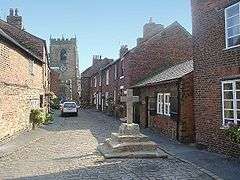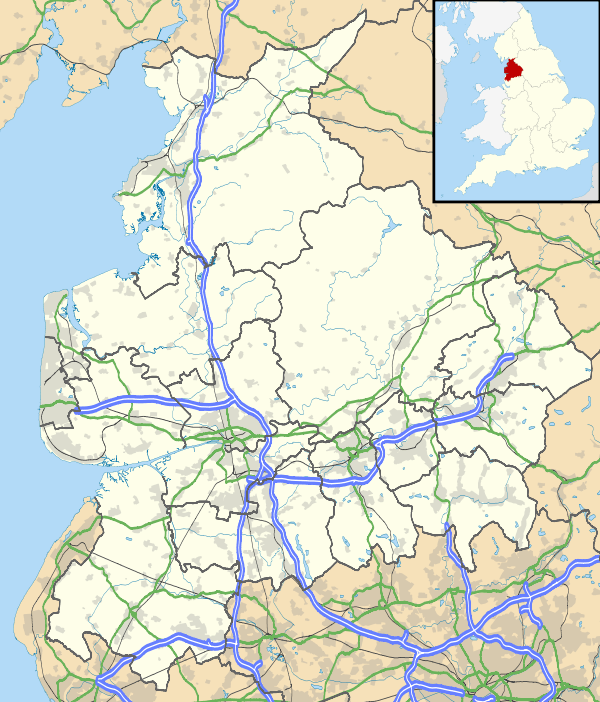Croston
| Croston | |
 Church Street, Croston village centre |
|
 Croston |
|
| Population | 2,917 (2011 Census) |
|---|---|
| OS grid reference | SD487187 |
| Civil parish | Croston |
| District | Chorley |
| Shire county | Lancashire |
| Region | North West |
| Country | England |
| Sovereign state | United Kingdom |
| Post town | LEYLAND |
| Postcode district | PR25,PR26 |
| Dialling code | 01257/01772 |
| Police | Lancashire |
| Fire | Lancashire |
| Ambulance | North West |
| EU Parliament | North West England |
| UK Parliament | Chorley |
|
|
Coordinates: 53°39′43″N 2°46′37″W / 53.662°N 2.777°W
Croston is a village and civil parish in Lancashire, England between Chorley and Southport and is next to the River Yarrow. St. Michael's and All Angels' Church is at the centre of the village. The population of the civil parish at the 2011 census was 2,917.[1] At the end of Church Street there is a stone cross which was erected in 1953. There is a 15th-century cobbled pack horse bridge which crosses the River Yarrow. The village green is used as a venue for the annual May Day Madness, Bastille Day (14 July) celebrations and Christmas Fair.
History
Croston began in the 7th century when St. Aidan arrived at the riverside settlements. In the absence of a church, a cross was erected as a place of worship. Croston literally means 'cross-town' and is derived from the two Old English words 'cross' and 'tūn' (town/homestead/village). The name is unique as there are no other Crostons in the UK.
Centuries ago the parish of Croston was far larger than it is today. It included Chorley, Much Hoole, Rufford, Bretherton, Mawdesley, Tarleton, Hesketh Bank, Bispham, Walmer Bridge and Ulnes Walton. These became independent parishes as a result of a series of separations between 1642 and 1821.[2] A charter granted by Edward I in 1283 permitted an annual medieval fair and market to be held on the village green. Pre 20th Century maps also depict a castle which is believed to have been of a wooden construction because there is no evidence of a stone structure.[3]
Croston used to have a large brick police station which has recently been refurbished. It was replaced by a smaller police station in the 1970s. It is similar in style to those in the surrounding areas, notably Bamber Bridge and Leyland police stations, however considerably smaller. This police station has recently closed.
Croston is twinned with the French town of Azay le Rideau, just south west of Tours, France.[4] Azay boasts a French Renaissance chateau, one of the famous chateaux of the Loire, and is a popular tourist hotspot.
Architecture
Croston Hall was built by the De Trafford family and was the manor house to the village of Croston. The hall was demolished in the 1960s, but there is a plan for a country house hotel to be built on its site. The family were Roman Catholics, and employed Edward Welby Pugin to design a family chapel in the grounds of the house in 1857. It is a small building constructed of rock-faced sandstone, and is in eclectic Gothic style.[5] It was left to the people of Croston on the death of the last De Trafford in the 1960s.
The parish church is dedicated to St Michael, and is a Grade II* listed building.[6] It appears to be based on a 15th-century design, but was reworked in the 16th century, and altered in the 17th. A partial rebuilding took place in the 18th century, and it was substantially altered in the 19th century. It consists of a nave and chancel with north and south aisles, mostly built of red sandstone with stone tiles.[7]
Croston Old School
Croston Old School is a Grade II listed building which originates from 1660, but was substantially rebuilt in 1827, when the work was funded by subscriptions. Date stones commemorating both the original build and the rebuild are evident in the first floor wall. It is located within the churchyard,[8] in the centre of the village at the end of Church Street and next to the church building. Until 1999 the buildings were used as a school. Croston Old School Community Trust's grant from the National Lottery for £481,062 has funded the majority of a scheme to create a community resource centre for Croston.
The building provides:
- A new home for Croston Pre-school
- A large community space with meeting rooms
- An exhibition area for local arts and heritage projects
- A reference library and a reading room
- Space for adult education
Bishop Rawstorne C of E Academy
Bishop Rawstorne Church of England Academy is the secondary school based in the village of Croston. It has between 800 and 900 pupils from the ages of 11 to 16. There are several famous people who have studied at Bishop Rawstorne. The footballer Mark Bonner who played professional for a number of years at local club Blackpool. Bonner had a stint and some other clubs however has since retired. Andrew Sprake the bassist from the band Failsafe, who featured in an episode of Inbetweeners, also studied here. Dave Dawson who used to DJ in Manchester at the well known club Sankeys Soap also studied here.
Geography
 |
Bretherton | Midge Hall | Leyland |  |
| Sollom | |
Ulnes Walton | ||
| ||||
| | ||||
| Rufford | Mawdesley | Eccleston |
See also
References
- ↑ "Civil Parish population 2011". Retrieved 15 January 2016.
- ↑ Farrer & Brownbill 1911, pp. 81-91.
- ↑ Philip Davis (2015-08-25). "Croston (The Gatehouse Record)". Gatehouse-gazetteer.info. Retrieved 2015-10-06.
- ↑ Mayoh, Emma (9 January 2012). "Croston's success is down to the growing support of the local community". Lancashire Life. Archant Community Media. Retrieved 27 June 2013.
- ↑ Historic England. "Roman Catholic Church of the Holy Cross (1072549)". National Heritage List for England.
- ↑ Historic England. "Church of St Michael (1163631)". National Heritage List for England.
- ↑ Farrar & Brownbill 1911, pp. 81-91.
- ↑ Historic England. "School in churchyard of Church of St Michael (1072547)". National Heritage List for England.
Bibliography
- Farrer, William; Brownbill, J, eds. (1911). A History of the County of Lancaster. Vol 6. Victoria County History.
External links
| Wikimedia Commons has media related to Croston. |